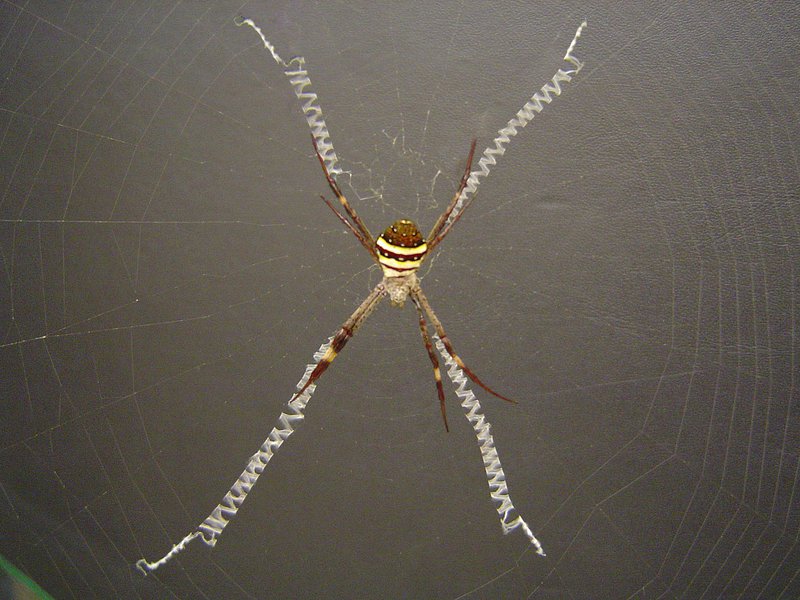St Andrew's Cross Spider
Saint Andrew's Cross Spider
Introduction
St Andrew's Cross Spiders are named for their bright, cross-shaped web decorations.
Identification
St Andrew's Cross Spiders are named for their bright web decorations - zig-zag ribbons of bluish-white silk that form a full or partial cross through the centre of the orb web. Females have a silvery carapace and a silver, yellow, red and black banded upper abdomen with two longitudinal yellow stripes below. The spider sits with the legs in pairs. The brown and cream coloured males are smaller than females.
The cream-coloured young spiders make a circular stabilimentum (like a white silk doily) that disguises them well and may also act as a sunshade. As the spider grows the 'doily' is gradually transformed into a 'cross'.
Habitat
The St Andrew's Cross Spiders build medium-sized orb webs, occupied day and night, on low shrubby vegetation.
The role of the cross-like web decoration, called the stabilimentum, has long been a puzzle. At first thought to strengthen or 'stabilise' the web, more recent ideas associate it with capturing prey or avoiding predators. The ribbon-like silk reflects ultra-violet light strongly. Such light is attractive to flying insects, which use it to locate food sources like flowers and to navigate through openings in the vegetation. If the stabilimentum silk attracts insects it may increase the web's prey catching efficiency. The silk decoration could also make the web and its owner more obvious to day-active predators like birds and wasps. However, the variability of the shape of the cross decoration (a complete cross; a partial cross with from one to three arms; or sometimes absent altogether) could make web recognition confusing for the predator. Another possibility is that the stabilimentum advertises a warning to predators like birds to stay away - after diving through the sticky web, the effort required to clean silk off plumage may deter birds from trying again.
Distribution
The St Andrew's Cross Spider is found in eastern Australia in habitats ranging from rainforest margins to open forest and heathland (Queensland, New South Wales, Victoria).
Feeding and diet
The prey of the St Andrew's Cross Spider includes flies, moths, butterflies, bugs and bees. These are usually secured by silk wrapping into a neat parcel before being bitten - although smaller prey may be bitten first.
Other behaviours and adaptations
When threatened, the St Andrew's Cross Spider responds either by dropping from the web or shaking it so vigorously that both spider and stabilimentum become a blur, confusing its attacker. These measures don't always succeed, as indicated by empty, damaged webs and the presence of these spiders as food in the mud cells of wasps.
Breeding behaviours
Mating occurs from summer to autumn and can be hazardous for the small male St Andrew's Cross Spiders. One or more males sit in the upper parts of the web - some may be missing legs, survivors of encounters with unreceptive females. The male constructs a mating thread within the web, onto which it attracts a receptive female by vibrating the thread. The female suspends its pear-shaped egg sac in a network of threads, often among leaves where the sac's greenish silk disguises it. Despite this, the egg sacs are often the target of parasitic wasps and flies.
References
- Craig, L.C. and Bernard, G.D. (1990). Insect attraction to ultraviolet-reflecting spider webs and web decorations. Ecology 71 (2): 616-623.
- Eisner, T. asnd Nowicki, S. (1983). Spider web protection through visual advertisement: role of the stabilimentum. Science 219: 185-187.
- Elgar, M.A. (1991). Sexual cannabilism, size dimorphism and courtship behaviour in orb-weaving spiders (Araneidae). Evolution 45 (2): 444-448.
- Elgar, M.A., Allen, R.A. and Evans, T.A. (1996). Foraging strategies in orb-spinning spiders: Ambient light and silk decorations in Argiope aetherea Walckenaer (Araneae: Araneoidea). Australian Journal of Ecology 21: 464-467.
- Main, B.Y. (1973). Spiders. Australian Naturalists Library. Collins, Sydney.
- McKeown, K. (1963). Australian Spiders. Angus and Robertson, Sydney.





